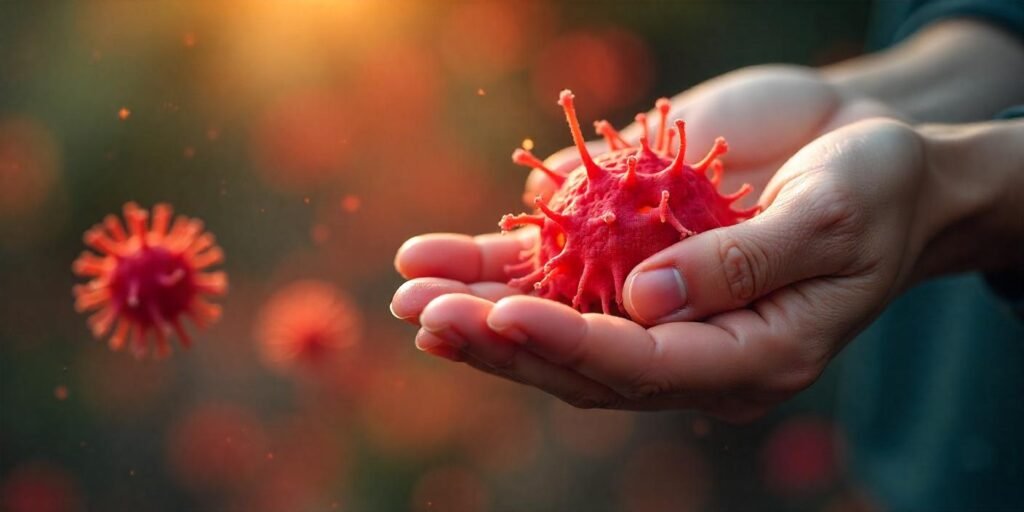Today we will discuss yeast infection symptoms, treatment, and prevention. Yeast infections, primarily caused by the Candida genus, are a common yet often misunderstood condition. Many individuals are left with questions regarding transmission, effective treatments, and prevention strategies. This comprehensive guide aims to shed light on yeast infections, focusing on actionable advice, Yeast Infection Symptoms, and evidence-based treatment options. Whether you’re seeking to understand whether Candida is a sexually transmitted disease or how to alleviate yeast infection symptoms quickly, this article serves as a valuable resource.

Table of Contents
Is Candida a Sexually Transmitted Disease?
To address the question, “Is Candida a sexually transmitted disease?” it is essential to clarify that while Candida can be present in genital areas and transmitted through intimate contact, it is not classified as a sexually transmitted infection (STI). Yeast infections are typically caused by an overgrowth of Candida, which normally resides in small amounts within the body. Factors such as antibiotics, immunosuppression, and changes in hormone levels can trigger this overgrowth.
The transmission of Candida through sexual activity is more about environmental factors rather than direct transmission like other STIs. For instance, if one partner has a yeast infection, the other may develop yeast infection symptoms as well due to the shared moist environment, but it is not a classic sexually transmitted disease.

Understanding Yeast Infection Symptoms
The yeast infection symptoms, specifically vaginal candidiasis, can include:
- Experiencing persistent itching and irritation in the vaginal area can be quite uncomfortable and disruptive to daily life. This sensation may range from a mild tickling to a more intense, burning itch that can be difficult to ignore. Alongside this, you might notice a change in vaginal discharge. Specifically, the presence of a thick, white discharge that has a characteristic appearance often described as resembling cottage cheese is a key indicator. Notably, this discharge is typically odorless.
- In addition to these primary yeast infection symptoms, you may also observe visible changes in the external genital area. This can include redness of the vulva, the outer lips surrounding the vagina, and noticeable swelling in the same region. These signs of inflammation can contribute to further discomfort.
- Furthermore, everyday activities can become uncomfortable. You might experience pain or a burning sensation during sexual intercourse, making it difficult or unpleasant. Similarly, the act of urinating may also cause discomfort, ranging from a stinging sensation to more pronounced pain. These yeast infection symptoms can significantly impact your well-being and quality of life.
Recognizing these yeast infection symptoms early is crucial for effective treatment. Women are particularly susceptible to recurrent infections, often leading to chronic discomfort.
How to Get Rid of a Yeast Infection in 24 Hours
When faced with the discomfort of a yeast infection, finding quick relief is a priority. Here are methods to tackle the issue, all aimed at delivering results within 24 hours.
3.1 Without Medication
For individuals interested in natural home remedies, there are several methods that might help alleviate yeast infection symptoms quickly.
- Apple Cider Vinegar: Renowned for its natural antifungal properties, apple cider vinegar can be a soothing addition to your self-care routine. When added to a warm bath (approximately one cup), it is believed to help create an environment less conducive to fungal overgrowth. The mild acidity of the vinegar may also help to alleviate some of the external itching and irritation associated with the condition. It’s important to ensure the bathwater is comfortably warm, not hot, and to avoid using undiluted apple cider vinegar directly on sensitive skin, as this could cause further irritation. Soaking for about 15-20 minutes may provide some temporary relief.
- Coconut Oil: This versatile natural oil is recognized for its potential antifungal properties, largely attributed to its medium-chain fatty acids, such as lauric acid. When applied externally to the affected vaginal area and vulva, coconut oil can create a protective barrier and may help to calm inflammation and reduce discomfort. Some proponents suggest that its antifungal components may also work to inhibit the growth of yeast. It’s best to use pure, unrefined coconut oil. Apply a thin layer to the irritated areas as needed for soothing relief.
- Probiotics: Cultivating a healthy balance of microorganisms within the body, particularly in the gut, is crucial for overall well-being. Incorporating yogurt that contains live and active cultures into your daily diet can be a beneficial way to introduce “good” bacteria, known as probiotics, into your system. These beneficial bacteria may help to restore a healthy microbial balance throughout the body, potentially including the vaginal area. While consuming probiotic-rich yogurt is a gentle approach, some individuals may also consider probiotic supplements for a more concentrated dose of beneficial bacteria. These supplements are designed to deliver live cultures to the gut, which can indirectly support a healthy vaginal flora.

These remedies may not eliminate the infection but can provide relief from yeast infection symptoms in as little as 24 hours.
3.2 For Men
It’s essential to note that while men can experience yeast infections, the approach may differ. For men looking to relieve yeast infection symptoms quickly:
- Proper hygiene practices are essential for overall health and well-being. It’s particularly important to maintain cleanliness in the genital areas, ensuring that they are thoroughly cleaned on a regular basis. Keeping these areas dry is also vital; moisture can create an environment conducive to the growth of bacteria or fungus. Pay special attention to hygiene after physical activities such as exercise, making sure to cleanse and dry the genital area following any workout or strenuous activity.
- For relief from yeast infection symptoms, consider using antifungal creams that you can purchase without a prescription from your local pharmacy or drugstore. These over-the-counter treatments are specifically formulated to target the fungal infection and can provide quick and noticeable improvement, leading to a rapid reduction in the discomfort and other problematic signs associated with Yeast Infections.
3.3 Overnight Solutions
In urgent situations, many seek immediate relief:
- Cold Compress: When experiencing the discomfort of a yeast infection, particularly the inflammation and swelling of the vulva, applying a cold compress can provide significant and immediate relief. The coolness helps to constrict blood vessels in the affected area, which in turn can diminish swelling and reduce the intensity of the itching and burning sensations. To create a cold compress, you can wrap a few ice cubes in a clean, thin cloth or use a commercially available cold pack. Gently apply the compress to the external vaginal area for short intervals, typically 5-10 minutes at a time, several times a day. Ensure that the cold is not applied directly to the skin to prevent potential irritation or discomfort from excessive cold. The soothing sensation can offer a temporary reprieve from the more bothersome yeast infection symptoms.
- Hydration: Maintaining adequate hydration by drinking plenty of water plays a supportive role in overall health and can indirectly aid the body’s natural processes. While it’s not a direct treatment for a yeast infection, staying well-hydrated can help support kidney function and the body’s ability to eliminate waste products. Some proponents believe that increased fluid intake may assist in flushing out excess yeast from the system, although scientific evidence for this specific mechanism is limited. Regardless, drinking sufficient water is essential for general well-being and can contribute to a healthier internal environment, potentially making the body more resilient. Aim for the recommended daily intake of water, adjusting based on your individual needs and activity levels. This simple habit can complement other self-care measures and medical treatments.

Hydration and Yeast Infections
One question frequently asked by those experiencing the discomfort of a yeast infection is, “What is the ideal amount of water I should consume to help flush out this yeast infection?” While there is no direct connection between water intake and eliminating a yeast infection, maintaining adequate hydration levels plays a significant role in supporting the body’s natural processes and contributing to a healthy internal environment.
Specifically, staying properly hydrated is crucial for maintaining a healthy balance of flora, which includes the beneficial bacteria that help keep yeast in check.A widely accepted and general recommendation for daily water consumption is to aim for at least 8 to 10 glasses of water per day. Drinking this amount of water is believed to enhance kidney function, allowing your kidneys to more effectively filter waste and toxins from the body.
This, in turn, supports overall health and well-being, which indirectly can benefit the body’s ability to manage imbalances, including yeast overgrowth. Therefore, while water won’t directly eliminate a yeast infection, adequate hydration is a cornerstone of good health and can support the body’s natural defenses.
Signs of Healing from Yeast Infections
Understanding the signs of healing is just as critical as identifying yeast infection symptoms. Positive indicators include:
- Reduced itching and irritation
- Diminishing discharge
- Overall feeling of comfort and reduced pain during urination or intercourse
Monitoring these signs ensures that the infection is responding to treatment measures.
Conclusion
Yeast infections, while inconvenient, are manageable with the right knowledge and proactive care. Understanding whether Candida is sexually transmitted, recognizing yeast infection symptoms, and exploring effective treatments fosters a comprehensive approach to dealing with this common condition. Empowering oneself with information leads to better health outcomes.
Frequently Asked Questions (FAQ)
1. What is the best medicine for the treatment of candidiasis?
- For many individuals, readily available over-the-counter antifungal treatments, such as those containing clotrimazole or miconazole as their active ingredient, are often a successful and efficient solution. These medications can usually provide a sufficient level of relief and are considered effective in addressing common fungal infections.
2. Can hot water kill a yeast infection?
- Although applying hot water may provide a fleeting sense of comfort and a reduction in perceived pain or unease, it’s important to understand its limitations. Specifically, the application of heat, while perhaps feeling good in the short term, does not address the underlying cause of an infection. Simply put, hot water can soothe and offer temporary relief from certain yeast infection symptoms; however, it is not a treatment that eradicates or eliminates infections at their source. The warmth may mask some discomfort, but it’s crucial to remember that it doesn’t possess any curative properties against the infection itself.
3. What are common signs of recurrent vaginal candidiasis?
- The yeast infection symptoms experienced will closely resemble those typically associated with a common yeast infection. These symptoms are also likely to manifest themselves on a recurring basis, appearing again and again. Furthermore, the issues will probably be stubborn and long-lasting, proving difficult to resolve quickly and tending to linger for extended periods of time.
4. What is vaginal candidiasis discharge?
- The discharge often presents as a dense and viscous substance, characterized by its white coloration. In terms of its smell, it is generally without any noticeable odor. A common way to describe its appearance and texture is to say that it closely resembles the food product known as cottage cheese, having a similar clumpy and curd-like consistency.
5. How can I prevent yeast infections?
- To effectively minimize the chances of experiencing outbreaks, several key measures should be taken into consideration. One crucial aspect involves consistently maintaining proper hygiene practices, which helps to eliminate potential irritants and infectious agents. Furthermore, choosing to wear clothing made from breathable fabrics is highly recommended, as these materials allow for adequate ventilation and prevent the buildup of moisture that can contribute to skin problems. In addition to these external factors, it’s also important to proactively manage blood sugar levels, as imbalances in blood sugar can sometimes trigger or exacerbate outbreaks.
By adhering to these guidelines and being proactive about one’s health, individuals can effectively manage yeast infections and reduce the likelihood of recurrence.


